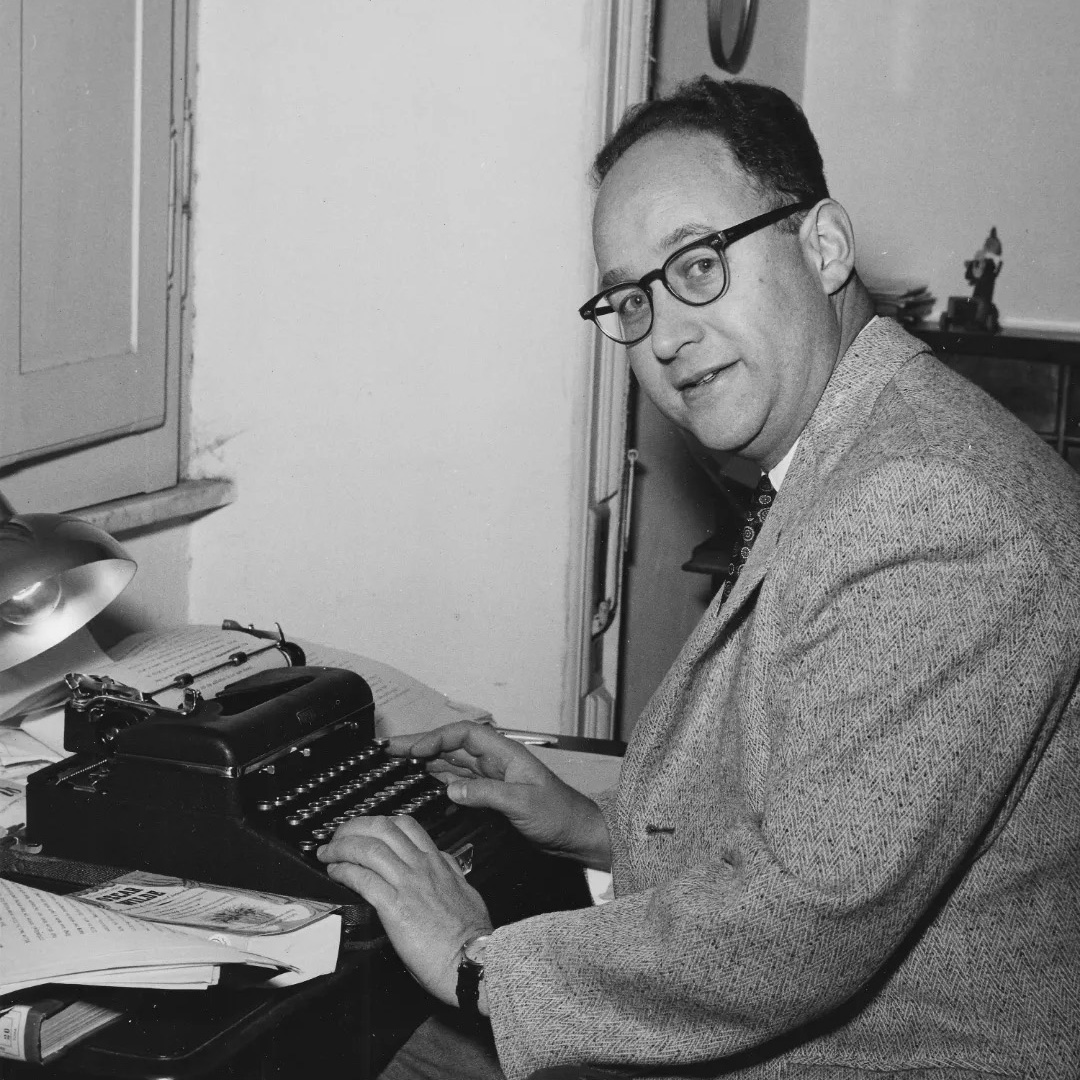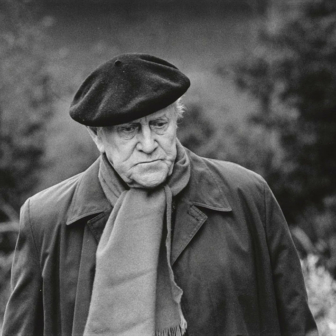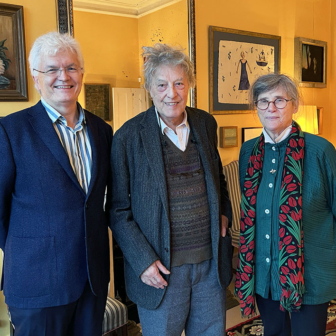The world of Joycean studies is, on the face of it, downright bizarre. What is there to say about the professors who pore over the puns and portmanteaus of Finnegans Wake? Or the crowds the world over who celebrate with fancy dress and fried liver breakfasts the day James Joyce was first jerked off by his wife-to-be, Nora? Perhaps it is only in such a peculiar world that a biography can loom so large.
For some, Richard Ellmann’s James Joyce (1959) is a masterpiece, a worthy recipient of the National Book Prize for non-fiction in 1960 and, for its second edition, the James Tait Black Memorial Prize in 1982. For others, it is a tombstone looming over Joyce and his work. The late Gabrielle Carey, for example — whose own life of Joyce came out posthumously in 2023 — regarded Ellmann’s biography as impenetrable and intimidating. That may be because it is almost impossible to write about James Joyce without sensing Ellmann’s shadow.
But Ellmann’s book is also highly regarded in own right. “The greatest literary biography of the twentieth century,” Anthony Burgess called it. When I was writing my PhD, one of my supervisors insisted I read it to see why. Its scholarship is detailed. Its approach is humane. The prose is clear and elegant. Its depth is considerable. And the Joyce created in its pages is funny, absurd, ambitious, grating, sentimental: a man and an artist who unifies contradictions without reconciling them.
Zachary Leader, an American literary scholar and biographer of Kingsley Amis and Saul Bellow, is another admirer of Ellmann’s big book. “An extraordinary achievement,” he calls it. Now, in Ellmann’s Joyce, an account of the biographer’s life and the making of the biography, he seeks to explain why.
A little over two decades ago, Adam Sisman wrote an acute and often comic account of James Boswell’s efforts to produce his biography of Samuel Johnson. Among the many qualities of Boswell’s Presumptuous Task (2002) was its portrayal of Boswell’s determination to present both the attractive and unattractive facets of his subject, and the consternation that this caused on publication. As Sisman pointed out, this empathetic but generally candid approach is one of the reasons why Boswell’s biography has endured. It also became the standard to which all biographers should try to aspire.
Leader identifies a similar critical novelty in Ellmann’s work and career. For his PhD at Yale in 1941, Ellmann had to seek special approval to write about W.B. Yeats (1865–1939). It was an audacious subject: at the time, literary scholars regarded contemporary subjects as unsuitable for serious study. But Ellmann got the go-ahead. Why? Partly because Yeats was dead, partly because Ellmann had already been approved as a doctoral candidate, and partly because he was at least not proposing to study the very-much-alive Auden, Eliot or Pound. The approval meant that Ellmann would produce the first dissertation at Yale on a twentieth-century poet; it was also a sign that Joyce, who had died only a few months earlier, would soon be an appropriate subject for study.
By then Ellmann had developed an outlook that would become key to his approach to biography. Born in 1918 to what Leader calls a “comfortably upper-middle-class” Jewish family in Michigan, Ellmann grew up with a strong love of literature and learning his mother had inculcated with poetry recitations and readings of authors including Dumas, Dickens, Hugo, Kipling and Twain. Ellmann also developed an early fascination with organising documents. His father, a lawyer, would bring home portfolios that Ellmann would fondle and arrange: “He was in his glory when he was up to his chin in important papers,” said his mother.
He became a confident young man, willing to be candid but also to propitiate. Hearing of his parents’ displeasure when his elder brother married a gentile, he wrote directly to rebuke them: “You will forgive my speaking so strongly but it seems to me that this persecution of my brother should stop, whether you think it’s for his own good or not.” Ellmann too married a gentile, Mary, in 1949, but he was so conscious of his parents’ likely disapproval that he and Mary eloped to Paris, from where he wrote to plead their forgiveness.
By then, many of the factors that would push him to work on Joyce were in place. When his study of Yeats was interrupted by the war, he served in the US Navy and the Office of Strategic Services. Stationed in Europe, he improved his paper-handling and organisational skills and also had the opportunity to meet Yeats’s widow, Georgie Hyde-Lees. She confirmed to Ellmann that a much-fabled 1902 meeting between Yeats and Joyce had actually taken place. Yeats, then a well-established poet, failed to impress Joyce, who was just a student at the time: “You are too old for me to help you,” Joyce said.
Memory of the remark — the arrogance of which delighted Ellmann — recurred when, having published his Yeats dissertation in 1948, Ellmann began considering a new project. A friend urged him toward Joyce and pointed to the contacts and expertise Ellmann had built in Ireland: “You can do it, [and] not many other people could.”
A lawyer with a collection of Joyce material — first editions, periodicals, critical works, biographical material — was willing to let Ellmann see it. Moreover, Ellmann had become critical of the only existing biography of Joyce, by Herbert Gormann, published in 1939. Taking note of the restrictions Gormann had worked under — the gaps in the material, the lack of detail — Ellmann recalled thinking: “I could do better than this.”
What follows in Ellmann’s Joyce is a fascinating account of the sleuthing, diplomacy, energy, patience, curiosity, luck and — perhaps most of all — the sheer unadorned time necessary to write a good biography. This may sound like a niche theme, but for anyone who’s written a book the dilemmas will be familiar and the ways Ellmann navigated them instructive.
Ellmann contended with touchy relatives. He encountered dead ends. He heard repeatedly of long-discarded papers and vital sources long in the grave. “I should have done this ten years ago,” he despaired privately. Rivals were keen to stake out territory, prospective interviewees were reluctant or guarded, enormous gaps in Joyce’s life needed filling. Letters and manuscripts had to be tracked down. An ever-burgeoning amount of critical material needed fossicking for gems.
“You could probably do it in about ten years on a full job,” a friend told Ellmann. “You could probably do it in five, but not sooner… What information there is is scattered all over. Just yanking together the presently known material is a two-year job, and even then there would be great yawning gaps, serious enough to impair any picture you might form of the man.”
Slowly but surely, Ellmann did the work. He overcame the reluctance of his interviewees by sending them his books to show his credentials and by using other names as references and authorities for his making contact. He flattered sources, made shows of inconveniencing himself for them, and refused to accept no as a final answer.
One source staved Ellmann off for a time by saying he was working on a memoir, then grudgingly granted a less-than-forthcoming interview. When he dropped dead six months later and his papers were deposited in the National Library of Ireland, Ellmann showed up immediately to consult them. Another source, who had known the young Joyce in Ireland, came to Ellmann’s attention via a letter Ellmann found in some Joyce family papers in Paris. With perseverance, intuition and luck, Ellmann enlisted a colleague who tracked the source down to an Indian reservation some hundred miles north of Saskatoon, Saskatchewan, where she was living under an entirely different name. “She made it possible,” Ellmann wrote later, “for me to feel that I had got back to the years immediately after Joyce’s birth.”
Ellmann had plenty of places to tread warily. He argued with Joyce’s son, Giorgio, over whether Joyce had carried on an affair. Proof hinged on the use of an epsilon, e, in several letters, in lieu of the letter “e.” Giorgio denied that his father had ever written this way and contended the letters were fakes. Ellmann went to Ulysses to point out that Leopold Bloom uses the epsilon to disguise himself when writing letters to a pen-pal named Martha — who shared a first name with the woman Ellmann was suggesting Joyce had had an affair with.
Then there were the letters that had been secreted in a Paris apartment since the German occupation. Exchanged by Joyce and his wife Nora, these were smutty and frank in a way that is still astonishing eighty-five years later. Ellmann was desperate to ensure that Giorgio didn’t get his hands on them — even as he conceded that the letters were rightfully his. He convinced the woman possessing the letters to let him draw on them, and only just in time: when Giorgio took possession of the letters in 1955 he locked them away.
Considerable tact was also required in dealing with Joyce’s brother Stanislaus. Ellmann won him over by encouraging his work on an autobiography and by offering to help place his writing with publishers. When Stanislaus died in 1955, the autobiography unfinished, Ellmann not only helped to edit it but was also given access by Stanislaus’s widow to a cellar full of papers. “From the point of view of a biographer,” he wrote, “I had tumbled into King Tut’s tomb.”
Travelling repeatedly through Ireland and Europe, Ellmann was exhilarated and excited — less by scandalous revelations than by “illuminating details which seemed to come together into a fairly coherent image.” At other times he was nervous. Having signed a contract with Oxford University Press in 1953 to deliver the manuscript within two years — a date he knew he would not meet — Ellmann became worried that competitors might scoop him. Should he produce a short “biographical study” instead? His publishers dissuaded him, but by 1956 Ellmann was wondering whether to make it two volumes instead. His motivation was to use the material from King Tut’s tomb before it could be sold to an institution — a sale Ellmann was helping to orchestrate, mind you — and accessed by a rival scholar. Again, the publishers dissuaded Ellmann. Anxieties about competitors prompted Ellmann nonetheless to publish essays that could claim ownership of discoveries archival and critical.
Foremost was the Ellmann’s exploration of the relationship between Joyce’s writing and his life, made possible, says Leader, by Ellmann’s biographical legwork. Over and over again, in those articles and in James Joyce, he was able to point to real-life models, to borrowings and adaptations, that placed Joyce in context and illuminated his working methods, or what Ellmann called Joyce’s “imaginative absorption of stray material.” He argued that Joyce “built his art upon a rock, and the rock was reality.” Repeatedly, Joyce transposed and recomposed the particulars of that reality for his fiction, augmenting them with imagination, giving them shadow and light.
This argument — which occasioned criticism that continues to this day — was one way of validating Ellmann’s biographical endeavours. Where literary biography has been dismissed as unnecessary for understanding a literary work or criticised for reducing the artistry of making literature, Ellmann believed his endeavours increased the understanding of the scale of that artistry. “To trace the materials of Ulysses,” he wrote, “is to discover a fuller admiration for the hand that changed them or, with equal mastery, let them alone.”
It is an assessment that has endured. Vivien Igoe’s The Real People of Joyce’s Ulysses (2016), which presents some six hundred biographies of people who appear, in various forms and disguises, in the novel, may be counted as one measure of how enduring Ellmann’s assessment was. Yet it is also one that those who have followed Ellmann continue to debate and argue against. As one of Ellmann’s friends told him, the resort to Joyce’s fiction to find congruencies or discrepancies was fraught with problems: “You are weaving both the works and the non-works into a single, supposedly factual, fabric.” Those problems were aggravated by the potential licence Ellmann was affording for later biographers to do the same. And they were all the more troublesome for coming in prose that was stylish, clear, seamless.
One of the more elegiac parts of Leader’s account is the snapshot it gives of an academic lifestyle and conditions now long gone. Every three years, as a professor at Northwestern University, Ellmann enjoyed a year’s paid leave that allowed him to travel repeatedly throughout Europe and Ireland, retracing Joyce’s steps, consulting archives and libraries, and conducting interviews. The resources required were enormous: “Like some gigantic financial operation conducted over about eight countries,” Ellmann wrote of it. As it turned out, that operation would span thirteen countries, involve more than 300 interviewees, and take seven years.
Funding from the Rockefeller Foundation, Northwestern University and Oxford University Press made it possible, as did the saintly forbearance and sacrifice of Ellmann’s wife, Mary. A notable literary scholar in her own right, she was consigned to the role of mother for much of the time Ellmann was researching and writing James Joyce, steering their three children — two of them born during the making of the book — and bearing the domestic load during his numerous absences. As one of her letters runs:
Maudie flooded bathroom again, great flood down through light fixture but this time not put on blink. Pierre [the dog] had back leg trouble yesterday, better today without vet. Couldn’t get to vet, car on blink, so money saved. Obviously we have entered a new phase of catastrophes confronted and stared down. Rather exhilarating.
The same may be said of Ellmann’s Joyce. Perhaps it is a peculiar kind, but to read an expansive account of how scholarship is done, how new work builds on old work, and how one of the monumental biographies of the twentieth centuries came to be is, oddly enough, exhilarating. Those Joyceans may be onto something. •
Ellmann’s Joyce: The Biography of a Masterpiece and Its Maker
Zachary Leader | Belknap Press of Harvard University Press | US$35 | 464 pages




